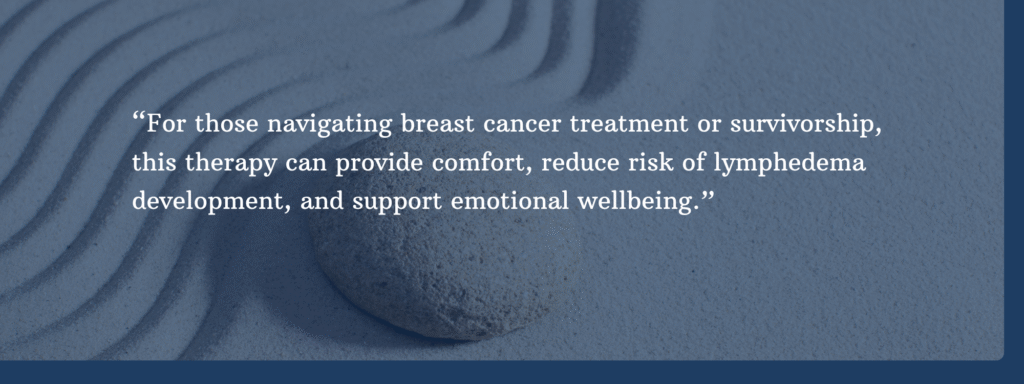
Massage can be very therapeutic both mentally and physically for breast cancer patients. Hear from one of our past grantees, Ava Barwick, Licensed Massage Therapist and Certified Lymphedema Therapist with Rooted Bodywork & Lymphatics. She helps break down how lymphatic massage can be a helping tool for breast cancer patients in active treatment and recovery.
Understanding Lymphatic Drainage for Breast Cancer Patients
Lymphatic massage, also called Manual Lymphatic Drainage (MLD), is a gentle, rhythmic technique designed to support the lymphatic system, which plays a crucial role in immunity, healing, and fluid balance. For those navigating breast cancer treatment or survivorship, this therapy can provide comfort, reduce risk of lymphedema development, and support emotional wellbeing.
What Is Lymphatic Drainage?
The lymphatic system is a network of vessels and lymph nodes that helps filter waste, manage swelling, and support the immune system. Lymphatic drainage uses slow, light, intentional movements to encourage lymph fluid to move more effectively through the body.
This therapy is not deep tissue work. Instead, it focuses on the superficial lymph pathways just beneath the skin. Because of its gentle nature, lymphatic drainage is deeply calming to the nervous system.
When Can Someone Receive Lymphatic Drainage?
Lymphatic drainage may be appropriate at different phases of the breast cancer journey, with guidance from your care team:
- Before Surgery: To help support immune function and prepare tissues.
- After Surgery (once cleared by your surgeon): Helps reduce swelling, support healthy scar tissue development, and encourage healing.
- During Chemotherapy and/or Radiation (with provider approval): Can help ease fatigue, stress, and discomfort.
- After Treatment: Supports recovery, scar tissue mobility, and long‑term lymphatic health.
Every individual’s medical situation is unique, so communication with your healthcare team is important.
Benefits of Lymphatic Drainage for Breast Cancer Patients
Lymphatic drainage may support:
- Reduction in swelling (including lymphedema risk management)
- Improved scar tissue mobility and post‑op comfort
- Reduced pain or heaviness in affected limbs or surgical sites
- Immune system support
- Nervous system regulation, promoting a sense of safety and calm
- Better sleep and improved energy levels
Many patients describe lymphatic massage as feeling deeply grounding and restorative.
Do Massage Therapists Need Special Training?
Yes. Lymphatic drainage requires specialized training beyond standard massage therapy education. Because the lymphatic system is delicate and directly connected to the immune system, safe and effective lymphatic work depends on understanding how fluid movement, scar tissue, and lymph pathway changes interact, especially in cancer care.
Therapists may hold:
- Manual Lymphatic Drainage (MLD) Certifications from recognized training programs
- Certified Lymphedema Therapist (CLT) credentials for more complex cases involving lymphedema management, fibrosis, or altered lymph node pathways
Important Note for Breast Cancer Patients: If you have had lymph nodes removed (such as during a lumpectomy, mastectomy, or sentinel/axillary node dissection), you should look for a CLT‑trained therapist. Node removal permanently alters lymph circulation, which increases the risk of lymphedema. A CLT is trained to:
- Support lymphatic rerouting when pathways are disrupted
- Recognize early signs of lymphedema
- Use precise, safe techniques to avoid triggering flare-ups or swelling
When choosing a therapist, patients may wish to ask:
- Where did you receive your lymphatic drainage training?
- Do you have experience working with post‑surgical or oncology clients?
- Are you comfortable coordinating care with my medical team?
The right therapist will welcome these questions and answer them transparently.
Additional Benefits of Massage During Cancer Care
Massage therapy as a whole, beyond lymphatic drainage, has been shown to support:
- Emotional processing and stress relief
- Body awareness and reconnection after medical trauma
- Reduction of muscle tension and anxiety
- Improved well‑being and self‑compassion
Touch can be incredibly healing, especially during a journey where the body has undergone so much.
Should You Confirm With Your Provider First?
In most cases, yes. Especially:
- During active chemotherapy or radiation
- After recent surgery
- If you have lymphedema or are at high risk
Your massage therapist and medical team can work together to ensure the therapy is safe, supportive, and tailored to your needs.
Ava is owner and operator of Rooted Bodywork & Lymphatics. A licensed massage therapist and certified lymphedema therapist with over 11 years of experience. Her own breast cancer journey reshaped her perspective on life, healing and touch. She knows that loving touch of massage can bring a body out of fight or flight mode and offer peace during treatment. She strives to find the root cause of discomfort. Her practice is built on empowerment through education, compassionate connection, and evidence-based bodywork.
